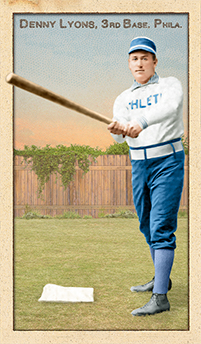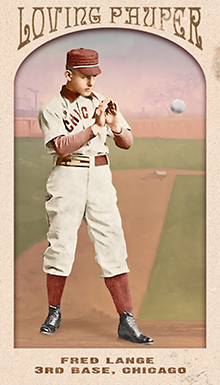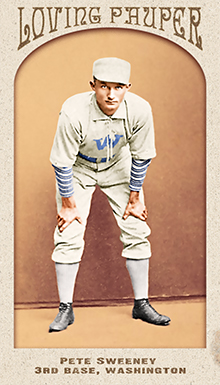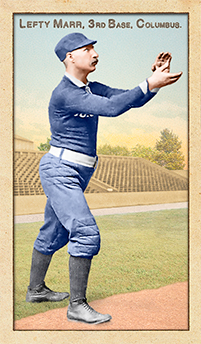
- Series: Beginnings: 1880's
- City: Philadelphia
- Team: Athletics (AA)
- League: American Association
Dennis Patrick Aloysius Lyons (1866-1929) was a strong hitting third-baseman over a thirteen year career in the major leagues from 1885 with Providence to 1897 with the Pirates. His lifetime batting average was .310. In 1890 he led the American Association in on-base percentage and slugging, and was second to Chicken Wolf in BA. He hit 62 home runs in the Deadball Era and was known as a formidable fielder in the no-glove era. Lyons’ era was also a time of rapid evolution in the game. In 1887, the year Denny “hit” safely in 52 straight, the pitcher’s box had been tightened and the pitcher’s delivery shortened to one step. Walks were also considered hits that year which has caused most modern students of the game to dismiss his “streak,” second only to Joltin’ Joe. But DiMaggio didn’t have to hit a fastball hurled from fifty feet. Only two of the 52 games was affected by walks but they were in the middle of the run. Despite such quibbles, Lyons was clearly a very accomplished player both offensively and afield.
- Consistently ranked among batting leaders in both leagues he starred in: AA and NL
- An Amos Rusie fastball broke two fingers and ended Denny’s ML tenure. He continued in the minors and hit .274 for the Beaumont Oil Gushers in 1903

- Series: 1880s: Loving Paupers
- City: Chicago
- Team: Maroons
- League: Western Association
Frederick W. Lange began his pro ball career as a teenager (how young is in dispute). He was from the San Francisco Bay Area and played in 1886 for the Greenhood and Morans team of oakland, a charter member of the California State League. The owners were haberdashers in Oakland who sponsored the club for three years. In 1887 the team floundered in last place despite having a lot of talent. The loss of star pitcher George Van Haltren, who went east to begin a long major league career, was a big blow. Fred Lange was a pal of Van Haltren’s and followed him to NY.
There is a fair degree of uncertainty and confusion surrounding Lange’s career, some of which appears to have been instigated by Lange himself. He had changed his surname to "Dolan" to sign with the G & Ms in Oakland so his parents wouldn’t know of his unworthy occupational choice. (Anyone familiar with the American Association’s reputation as the “beer and whiskey league” can sympathize with Fred’s folks as the 1880s were an era of free-wheeling debauchery in big time baseball.) But there is a reference by authors Dick Dobbins and Jon Twichell in their book Nuggets on the Diamond:Professional Baseball in the Bay Area from the Gold Rush to the Present, published in 1994, to the effect that Fred Lange was also “Willard Brown,” who went on to play for the NY Giants after leaving Oakland in 1886. Catcher William "California" Brown did play for the Giants from 1887-1889 and, perhaps not coincidentally, had played for Greenhood and Morans as well. Adding to the confusion, the editors of The Photographic Baseball Cards of Goodwin & Co mistakenly list William Brown as "Willard" in that seminal encyclopedia on the Old Judge universe. One possible theory to the confusion, however unlikely, is still intriguing: In moving East to pursue his big league dreams, might Fred Lange have adopted the name "Willard Brown" as a sort of hopeful and opportunistic nominal doppelganger to William Brown?
The truth is, most likely, that the mystery and confusion around Fred Lange's name and identity is the result of a more modern human error and that there is no mystery at all. Fred Lange & William Brown are clearly different people, perhaps even friends, who look nothing alike and appear together in a Greenhood & Morans team photo from 1886, thereby dispelling the notion that Brown was Lange's alter ego. Furthermore, there is no record of a "Willard Brown" playing professional baseball in the 19th century and the Old Judge folks were unconfused on the players' identities, with each player getting five unique poses in the series with no misspellings, overlay or confusion between them. Given that Van Haltren knew both Lange and Brown and that Van Haltren and Brown had quickly established themselves as bone fide big leaguers, it seems unlikely that Lange would attempt to perpetrate such a thinly veiled con while striving to join his friends on the big stage.
- Further adding to the confusion around Lange's name, the New York Metropolitan Museum of Art mistakenly lists Lange as "Lance" for the two Old Judge cards of Lange that reside in the museum's collection.
- Lange later authored an influential tome of his own: History of Baseball in California and Pacific Coast Leagues (1847-1938)
Auction History
Cartophilia
Old Judge Pose: 272-4

- Series: 1880s: Loving Paupers
- City: Washington, D.C.
- Team: Nationals
- League: National League
Peter Jay Sweeney (1863-1901) played infield and outfield on the west coast beginning at the tender age of 15 with two San Francisco clubs. He moved across the bay to Oakland in 1881, then came back to Baghdad by the Bay with the SF Haverlys in 1884-85. At age 24, Pete got his big chance, joining the Washington Nationals in '88. He returned to D.C. the following season and was moved to the St. Louis Browns later in '89. They demoted him briefly to the St. Paul Apostles, but brought Sweeney back in 1890 before trading him to the Philadelphia Athletics who sent him later the same season to the Louisville Colonels. His major league tenure ended in Louisville with Pete seeing action for four clubs in a mere three years. He was far from finished with baseball, however. Sweeney had a coast-to-coast season in 1891, playing back home for Oakland and finishing the year with the Rochester Hop Bitters in the Eastern Association. Thereafter, this wanderer would roam from California League teams to the east coast and even a season with the Nashville Tigers of the Southern League. Having begun in 1879, this lifer didn't hang 'em up until concluding the 1897 campaign with the Sunbury Pirates of the Central Pennsylvania League. There was a reason he spent most of his time in the minors: he couldn't hit big league pitching. Pete's average for his four MLB clubs was a paltry .209. Yet, he could thrive in the lower levels of the game. When he left the big leagues for Rochester, Sweeney led the Eastern Association in home runs.
- Not a lot of native Californians got to play in the majors in the nineteenth century, but while playing for the San Francisco Knickerbockers in 1879, Sweeney did play alongside one early luminary: The Only Nolan. A pitcher, perhaps from Canada, Edward Nolan sported one of the great appellations in the game
- Only one teammate from the Haverlys made it to the majors: John Smith. He had a cup of coffee in 1882 with the Troy Trojans and Worcester Ruby Legs, then of the National League
Auction History
Cartophilia
Old Judge Pose: 451-1

- Series: 1880s: Loving Paupers
- City: New York
- Team: Giants
- League: National League
Elmer Ellsworth Cleveland (1862-1913) was a third baseman and shortstop who was a good enough hitter to carve out a very respectable pro career, principally in the minors. He began with Johnstown of the Western Interstate League in 1883 and, as so many of his talent and age, got a chance at the “big leagues” the following season with the Cincinnati Outlaw Reds, the aptly-named club in the upstart Union Association. Elmer actually had a great season for Cincy playing against other mostly minor league talent. He hit .322 in 29 games. His limitations as a hitter caught up to him in his future appearances with major league teams. He next came up with the New York Giants in 1888, getting into nine games before being shipped to Pittsburgh's Alleghenys where he got into 30 games. His combined average tumbled to .235. Cleveland got one more shot, with the Columbus Solons of the American Association in 1891 where his miserable .171 average signaled the end of any dreams of big league glory. Nevertheless, he stayed in minor league baseball through his twenties, finally calling it quits after playing the 1892 season back in Johnstown with the Pirates, now in the Pennsylvania State League and finishing up the year with Danville in the same circuit. His opponents that year included the Wilkes-Barre Coal Barons, the Reading Actives and the Lebanon Pretzel Eaters.
- Cleveland must have cut an imposing figure in that era, standing 5'11” and tipping the scales at 190 lbs. However, the sturdy third baseman learned the unfortunate consequences of not hitting one's weight
Auction History
Cartophilia
Old Judge Pose: 80-2

- Series: Beginnings: 1880's
- City: Columbus
- Team: Solons
- League: American Association
Charles W. Marr (1862-1912) was a Cincinnati lad who started his pro ball career in Evansville, IN in 1884, moving to Nashville the following season and Syracuse, NY with the Stars in '86 before getting a call-up to his hometown at the end of that campaign with the Red Stockings of the American Association. Lefty played in only eight games for the Red Stockings, but hit .276. He then detoured back to the minors for the next two years with the Stars, now of the International Association. In 1889 Lefty got his chance to play regularly in the big leagues when he was signed by the AA's Columbus Solons. He played third and showed off a sparkling .306 average, second only to Dave Orr among the starters. He returned home to the National League's Reds in 1890 where he played primarily in the outfield and continued his fine hitting with a .298 average, helping the squad to a fourth place finish. Marr began the next year with the Reds but soon moved to the Players' League cross-town rivals - Kelly's Killers. That rather tumultuous season for baseball saw Marr end the campaign back with the NL club for a single game. In all, Lefty saw action in three leagues with four years of experience in the majors. His two years with the Solons and Reds bumped his lifetime batting average to .289. He had speed, evidenced by his league-leading 15 triples in '89 with Columbus which he followed with a dozen more for the Reds in '90.
- Marr's ML statistics include a .289 average with 417 hits, 35 triples, 92 stolen bases and 186 RBI
- Marr was far from through with baseball when he left Cincinnati. The next season saw him out west with Spokane and Butte. He traveled south to Macon for the '93 campaign and spent the next several years seeing the country: IA, TN, MN, VA, CT and PA
- Lefty retired from the game after the 1898 season with the Norfolk Jewels of the Atlantic League




